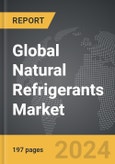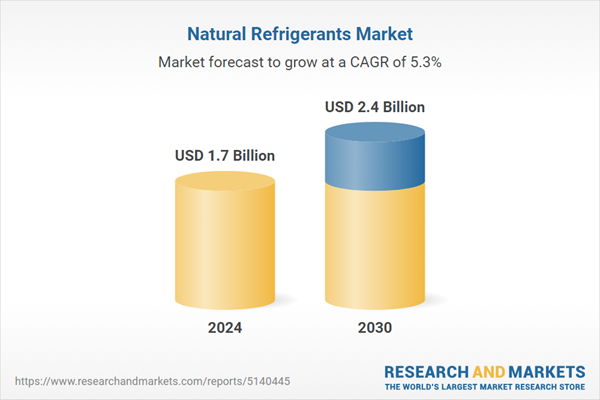The global market for Natural Refrigerants was valued at US$1.7 Billion in 2024 and is projected to reach US$2.4 Billion by 2030, growing at a CAGR of 5.3% from 2024 to 2030. This comprehensive report provides an in-depth analysis of market trends, drivers, and forecasts, helping you make informed business decisions. The report includes the most recent global tariff developments and how they impact the Natural Refrigerants market.
Segments: Type (Carbon Dioxide, Ammonia, Hydrocarbons, Other Types); Application (Refrigerators, Air Conditioning Systems).
Geographic Regions/Countries: World; United States; Canada; Japan; China; Europe (France; Germany; Italy; United Kingdom; Spain; Russia; and Rest of Europe); Asia-Pacific (Australia; India; South Korea; and Rest of Asia-Pacific); Latin America (Argentina; Brazil; Mexico; and Rest of Latin America); Middle East (Iran; Israel; Saudi Arabia; United Arab Emirates; and Rest of Middle East); and Africa.
The analysts continuously track trade developments worldwide, drawing insights from leading global economists and over 200 industry and policy institutions, including think tanks, trade organizations, and national economic advisory bodies. This intelligence is integrated into forecasting models to provide timely, data-driven analysis of emerging risks and opportunities.
Global Natural Refrigerants Market - Key Trends & Drivers Summarized
What Are Natural Refrigerants, and Why Are They Crucial for Sustainable Cooling?
Natural refrigerants are environmentally friendly cooling agents used in refrigeration and air conditioning systems. Unlike synthetic refrigerants, such as hydrofluorocarbons (HFCs), natural refrigerants have minimal or zero impact on global warming and ozone depletion. Common types of natural refrigerants include ammonia (R-717), carbon dioxide (R-744), and hydrocarbons like propane (R-290) and isobutane (R-600a). These refrigerants are derived from natural sources and have been gaining traction due to their low environmental footprint and regulatory compliance with global climate policies like the Kigali Amendment to the Montreal Protocol. Natural refrigerants are widely used across industries such as food and beverage processing, HVAC, automotive, and industrial refrigeration, driving the global transition toward more sustainable cooling solutions.How Are Natural Refrigerants Revolutionizing the Cooling Industry?
Natural refrigerants are reshaping the cooling industry by offering a viable and eco-friendly alternative to traditional synthetic refrigerants. These refrigerants have become increasingly important as industries look to phase out ozone-depleting substances (ODS) and high-global-warming-potential (GWP) refrigerants. With the growing awareness of climate change and the push for energy-efficient systems, industries such as commercial refrigeration, HVAC, and transportation are rapidly adopting natural refrigerants. Ammonia, for instance, is widely used in large-scale industrial refrigeration systems due to its high efficiency and zero GWP, while carbon dioxide is gaining popularity in commercial and industrial settings because of its non-toxic and non-flammable properties. Additionally, hydrocarbons are being utilized in domestic refrigeration and small-scale commercial systems, further driving the adoption of natural refrigerants in everyday applications.What Emerging Trends Are Shaping the Natural Refrigerants Market?
Several key trends are driving innovation and adoption in the natural refrigerants market. The push for energy-efficient solutions is a major trend, as companies are developing new technologies that enhance the efficiency of systems using natural refrigerants. For example, advances in heat exchanger design and compressor technology are improving the performance of ammonia and CO2-based systems. Another significant trend is the increasing use of natural refrigerants in transcritical CO2 systems, which are being widely adopted in cold storage and supermarket refrigeration due to their superior energy performance in warmer climates. Regulatory frameworks, particularly in Europe and North America, are also shaping the market, as governments impose stricter limits on the use of high-GWP refrigerants, driving industries to transition to natural alternatives. Additionally, the development of training programs and safety guidelines for handling natural refrigerants is improving market readiness, as these refrigerants, particularly ammonia, require specialized knowledge and equipment for safe use.What Is Driving the Growth of the Natural Refrigerants Market?
The growth in the natural refrigerants market is driven by several factors, including increasing regulatory pressure to reduce greenhouse gas emissions, technological advancements in refrigeration systems, and the growing demand for energy-efficient cooling solutions. The implementation of stringent regulations to phase out synthetic refrigerants with high GWP is pushing industries to adopt natural refrigerants as a sustainable alternative. Additionally, the rising demand for environmentally friendly cooling solutions in sectors like food and beverage, retail, and industrial manufacturing is accelerating the use of natural refrigerants in both new and retrofitted systems. Consumer awareness and preference for green products are further driving demand in sectors such as domestic refrigeration and HVAC. Technological advancements, particularly in CO2-based transcritical systems and low-charge ammonia systems, are enhancing the efficiency and safety of natural refrigerants, making them more accessible for wider applications. Finally, the expansion of cold chain logistics, particularly in emerging markets, is creating significant opportunities for natural refrigerant adoption, as industries seek to modernize their refrigeration infrastructure in compliance with global environmental standards.Report Scope
The report analyzes the Natural Refrigerants market, presented in terms of units. The analysis covers the key segments and geographic regions outlined below.Segments: Type (Carbon Dioxide, Ammonia, Hydrocarbons, Other Types); Application (Refrigerators, Air Conditioning Systems).
Geographic Regions/Countries: World; United States; Canada; Japan; China; Europe (France; Germany; Italy; United Kingdom; Spain; Russia; and Rest of Europe); Asia-Pacific (Australia; India; South Korea; and Rest of Asia-Pacific); Latin America (Argentina; Brazil; Mexico; and Rest of Latin America); Middle East (Iran; Israel; Saudi Arabia; United Arab Emirates; and Rest of Middle East); and Africa.
Key Insights:
- Market Growth: Understand the significant growth trajectory of the Carbon dioxide segment, which is expected to reach US$1.0 Billion by 2030 with a CAGR of a 6.0%. The Ammonia segment is also set to grow at 4.6% CAGR over the analysis period.
- Regional Analysis: Gain insights into the U.S. market, valued at $446.9 Million in 2024, and China, forecasted to grow at an impressive 8.3% CAGR to reach $542.1 Million by 2030. Discover growth trends in other key regions, including Japan, Canada, Germany, and the Asia-Pacific.
Why You Should Buy This Report:
- Detailed Market Analysis: Access a thorough analysis of the Global Natural Refrigerants Market, covering all major geographic regions and market segments.
- Competitive Insights: Get an overview of the competitive landscape, including the market presence of major players across different geographies.
- Future Trends and Drivers: Understand the key trends and drivers shaping the future of the Global Natural Refrigerants Market.
- Actionable Insights: Benefit from actionable insights that can help you identify new revenue opportunities and make strategic business decisions.
Key Questions Answered:
- How is the Global Natural Refrigerants Market expected to evolve by 2030?
- What are the main drivers and restraints affecting the market?
- Which market segments will grow the most over the forecast period?
- How will market shares for different regions and segments change by 2030?
- Who are the leading players in the market, and what are their prospects?
Report Features:
- Comprehensive Market Data: Independent analysis of annual sales and market forecasts in US$ Million from 2024 to 2030.
- In-Depth Regional Analysis: Detailed insights into key markets, including the U.S., China, Japan, Canada, Europe, Asia-Pacific, Latin America, Middle East, and Africa.
- Company Profiles: Coverage of players such as A-Gas International, Air Liquide SA, Arkema Group, Asahi Glass Co., Ltd., Changsu 3f Fluorochemical Industry Co. Ltd. and more.
- Complimentary Updates: Receive free report updates for one year to keep you informed of the latest market developments.
Some of the 47 companies featured in this Natural Refrigerants market report include:
- A-Gas International
- Air Liquide SA
- Arkema Group
- Asahi Glass Co., Ltd.
- Changsu 3f Fluorochemical Industry Co. Ltd.
- Daikin Industries Ltd.
- Dongyue Group Ltd.
- Gas Servei S.A.
- Gujarat Fluorochemicals Ltd.
- Harp International Ltd.
- Honeywell International, Inc.
- Linde AG
- Mexichem Fluor S.A. de C.V.
- Navin Fluorine International Limited
- Oz-Chill Refrigerants
- Quimobasicos
- Refrigerant Solutions Inc.
- Shandong Yuhuang Chemical (Group) Co., Ltd.
- Sinochem Group Co., Ltd.
- SRF Ltd.
- Tazzetti S.p.A.
- The Chemours Company
- Zhejiang Fotech International Co Ltd.
- Zhejiang Juhua Co., Ltd.
Tariff Impact Analysis: Key Insights for 2025
Global tariff negotiations across 180+ countries are reshaping supply chains, costs, and competitiveness. This report reflects the latest developments as of April 2025 and incorporates forward-looking insights into the market outlook.The analysts continuously track trade developments worldwide, drawing insights from leading global economists and over 200 industry and policy institutions, including think tanks, trade organizations, and national economic advisory bodies. This intelligence is integrated into forecasting models to provide timely, data-driven analysis of emerging risks and opportunities.
What’s Included in This Edition:
- Tariff-adjusted market forecasts by region and segment
- Analysis of cost and supply chain implications by sourcing and trade exposure
- Strategic insights into geographic shifts
Buyers receive a free July 2025 update with:
- Finalized tariff impacts and new trade agreement effects
- Updated projections reflecting global sourcing and cost shifts
- Expanded country-specific coverage across the industry
Table of Contents
I. METHODOLOGYII. EXECUTIVE SUMMARY2. FOCUS ON SELECT PLAYERSIII. MARKET ANALYSISSOUTH KOREAREST OF ASIA-PACIFICARGENTINABRAZILMEXICOREST OF LATIN AMERICAIRANISRAELSAUDI ARABIAUNITED ARAB EMIRATESREST OF MIDDLE EASTIV. COMPETITION
1. MARKET OVERVIEW
3. MARKET TRENDS & DRIVERS
4. GLOBAL MARKET PERSPECTIVE
UNITED STATES
CANADA
JAPAN
CHINA
EUROPE
FRANCE
GERMANY
ITALY
UNITED KINGDOM
SPAIN
RUSSIA
REST OF EUROPE
ASIA-PACIFIC
AUSTRALIA
INDIA
LATIN AMERICA
MIDDLE EAST
AFRICA
Companies Mentioned (Partial List)
A selection of companies mentioned in this report includes, but is not limited to:
- A-Gas International
- Air Liquide SA
- Arkema Group
- Asahi Glass Co., Ltd.
- Changsu 3f Fluorochemical Industry Co. Ltd.
- Daikin Industries Ltd.
- Dongyue Group Ltd.
- Gas Servei S.A.
- Gujarat Fluorochemicals Ltd.
- Harp International Ltd.
- Honeywell International, Inc.
- Linde AG
- Mexichem Fluor S.A. de C.V.
- Navin Fluorine International Limited
- Oz-Chill Refrigerants
- Quimobasicos
- Refrigerant Solutions Inc.
- Shandong Yuhuang Chemical (Group) Co., Ltd.
- Sinochem Group Co., Ltd.
- SRF Ltd.
- Tazzetti S.p.A.
- The Chemours Company
- Zhejiang Fotech International Co Ltd.
- Zhejiang Juhua Co., Ltd.
Table Information
| Report Attribute | Details |
|---|---|
| No. of Pages | 197 |
| Published | April 2025 |
| Forecast Period | 2024 - 2030 |
| Estimated Market Value ( USD | $ 1.7 Billion |
| Forecasted Market Value ( USD | $ 2.4 Billion |
| Compound Annual Growth Rate | 5.3% |
| Regions Covered | Global |









